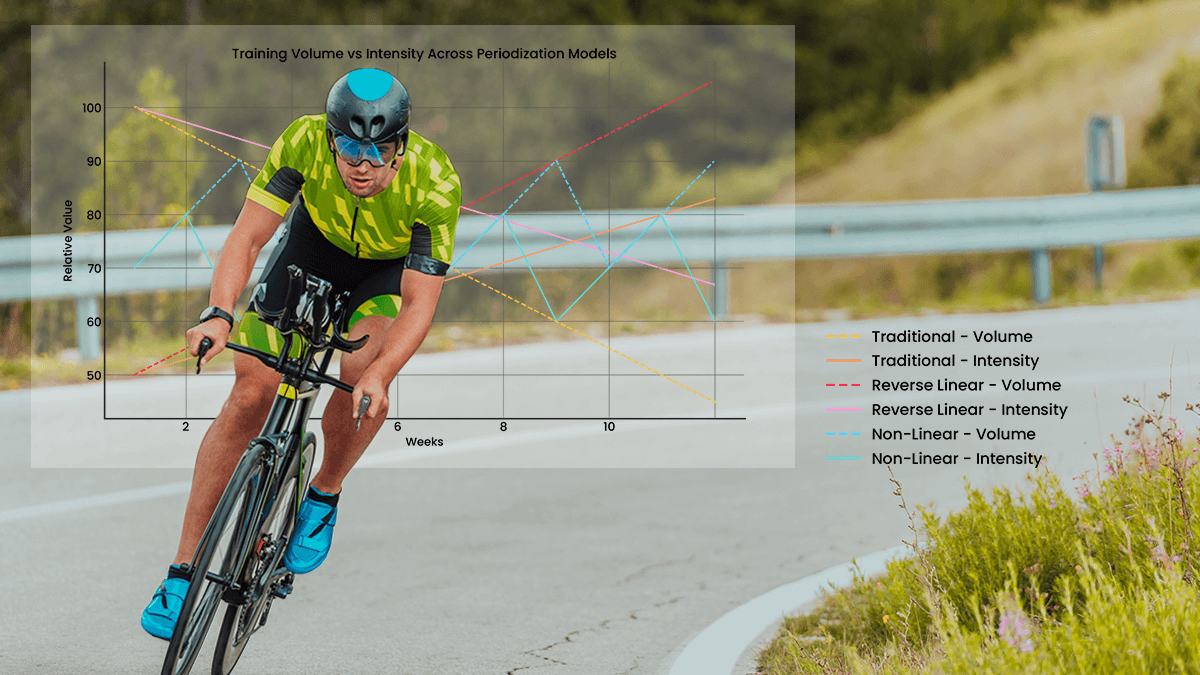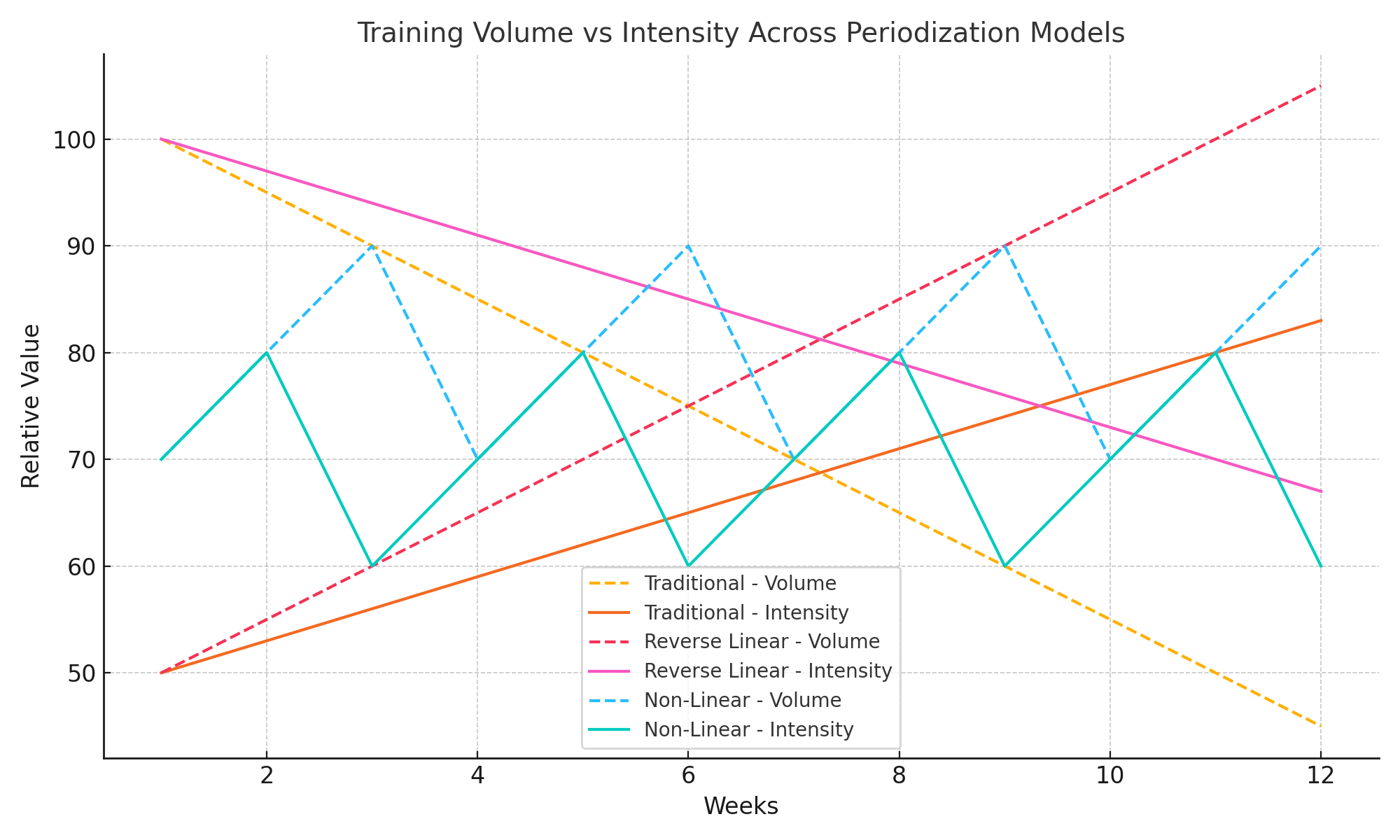Periodization Models in Endurance Sports: Designing Peak Performance

Why Periodization Is Like a Flight Plan
Every endurance coach understands the risks of unstructured training: overtraining, underperformance, stagnation, and even burnout. But structuring training based on science—and not guesswork—is what transforms effort into elite performance.
That’s where periodization models come into play. Think of them as a flight plan for your coaching journey. Each model offers a specific route, defined by changes in training volume and intensity across time. Choosing the right model means aligning it with your athlete’s background, competition schedule, and physiological needs.
What Is Periodization?
Periodization is the planned variation of training loads—volume, intensity, and focus—over time. The training year (macrocycle) is subdivided into mesocycles (multi-week blocks) and microcycles (usually 1-3-week training units). This strategic structure optimizes adaptations and performance.
“Periodization is the planned manipulation of training variables to maximize performance at predetermined times.”
— Issurin, V. B. (2010), Sports Medicine
Periodization: Structured and Methodical
To achieve a structured and methodical training process, coaches must develop an Annual Training Plan (ATP). This plan serves as the “big picture” or roadmap, guiding an athlete from preparation to peak performance. Periodization involves dividing the training year into specific phases, each targeting particular physiological adaptations and performance goals.
“Periodization is the systematic planning of athletic training, aiming to reach the best possible performance in the most important competition.”
— Nielsen et al., 2012; Klien et al., 2013
Phases of the Annual Training Plan
The ATP is typically broken down into macrocycles, mesocycles, and microcycles. Here’s a breakdown of the six primary phases that ensure a complete year-round strategy:
- Preparatory Phase: Establishes the foundation for the training year, focusing on general fitness, strength, and technique development.
- Base Training Phase: Emphasizes building aerobic endurance and muscular strength through increased training volume.
- Build Phase: Introduces higher-intensity workouts to enhance speed, power, and race-specific skills.
- Peak Phase: Fine-tunes performance with reduced volume and heightened intensity, leading up to key competitions.
- Race Phase: Involves tapering to ensure optimal performance during A-priority races.
- Transition Phase: Allows for recovery and regeneration post-competition, preparing the athlete for the next training cycle.
Each phase is carefully scheduled to align with the athlete’s competition calendar, ensuring a synchronized balance between overload and recovery.

Understanding Volume and Intensity in Training
Before exploring specific models, it’s important to clarify two foundational concepts:
- Volume = How much training an athlete does (duration or distance).
- Intensity = How hard the athlete trains (pace, power, heart rate).
These two are typically inversely related – when doing high volume you typically do less intensity and as your intensity increases, your volume comes down. Managing their balance over time is at the heart of effective periodization.
Integration of Periodization Models
Within each phase of the ATP, different periodization models can be applied to optimize training outcomes:
- Traditional (Linear) Periodization: Suitable during the Base and Build Phases to gradually increase intensity.
- Reverse Linear Periodization: Effective in the Build and Peak Phases for experienced athletes focusing on high-intensity efforts.
- Non-Linear (Undulating) Periodization: Beneficial throughout the training year for athletes requiring frequent adaptations.
- Block Periodization: Ideal in the Peak Phase for targeting specific performance attributes.
By aligning periodization models with the appropriate phases, coaches can tailor training programs to meet the unique needs of each athlete, ensuring a systematic approach to achieving peak performance.
Visual Comparison of Periodization Models
This graph illustrates how volume and intensity change over a 12-week period in three popular models:

1. Traditional (Linear) Periodization
Description
The traditional model begins with high volume and low intensity, gradually transitioning to lower volume and higher intensity. Think of it as a pyramid: broad aerobic base at the bottom, sharpening speed and specificity toward the peak.
Science-Backed Origins
Pioneered by Lev Matveyev in the 1960s, this model became the foundation of modern training systems in endurance and strength sports.
“Gradual increases in training intensity can safely elevate aerobic capacity and muscular efficiency.”
— Matveyev, L. P. (1977)
Best For:
- Beginner or intermediate endurance athletes
- Off-season base building
- Athletes returning from injury or long breaks
| Pros | Cons |
| Low risk of overtraining | May lack excitement or stimulus for adaptation in advanced athletes |
| Solid aerobic development | Less effective for events lasting >2 hours, e.g., marathons or Ironman |
| Easy to implement and monitor |
2. Reverse Linear Periodization
Description
This model starts with high intensity and low volume. As the weeks progress, volume increases and intensity declines slightly. It’s the inverse pyramid—building early speed and sharpening with endurance later.
Best For:
- Experienced athletes with a strong aerobic base
- Ultra-distance training and long-course triathlon
- Athletes who thrive on early psychological confidence from intense sessions
| Pros | Cons |
| Early adaptation to race pace and neuromuscular load | Higher injury risk if base fitness is insufficient |
| Builds confidence by hitting high targets early | Demands robust recovery practices |
“Reverse periodization is highly effective for developing performance in ultra-endurance disciplines with existing aerobic foundations.”
— Prestes et al. (2009)
3. Non-Linear (Undulating) Periodization
Description
Rather than following a linear path, this model varies training variables frequently—sometimes even daily. For example, VO2max, lactate threshold, and strength sessions may all occur within the same week.
Best For:
- Seasoned athletes with year-round racing schedules
- Sports like cycling, running, or rowing with multiple competitions
| Pros | Cons |
| Prevents performance stagnation | Requires careful planning to avoid overlap or overload |
| Trains multiple energy systems concurrently | Less effective for major peak events |
| Adds variety and psychological engagement |
“Undulating programs offer superior retention of multiple physical traits, but may lack specificity for single-peak planning.”
— Buford et al. (2007)
4. Block Periodization
Description
Block periodization focuses training into concentrated blocks, targeting a limited set of abilities. Instead of developing all traits simultaneously, each block emphasizes one key adaptation—such as VO2max, muscular endurance, or strength.
Each block is followed by a recovery and transition phase, creating a wave-like rhythm across the macrocycle.
Best For:
- Elite or advanced athletes seeking marginal gains
- Athletes aiming for multiple peaks per year (e.g., spring and fall race seasons)
| Pros | Cons |
| Enables highly focused adaptation | High risk of overreaching or injury without monitoring |
| Enhances performance in targeted traits | Not practical for amateur athletes with fluctuating schedules |
| Supports multiple race peaks |
“Block training enhances concentrated overload, yielding stronger adaptations in elite populations.”
— Issurin, V.B. (2008)
Overview of Major Periodization Models
| Model | Focus | Best For | Risk Level | Key Characteristics |
| Traditional (Linear) | Aerobic base building | Beginners or post-off-season | Low | Gradual intensity increase |
| Reverse Linear | Early-season intensity | Experienced athletes | Moderate | High intensity early, volume increases later |
| Non-Linear (Undulating) | Multi-focus training | Experienced athletes racing frequently | Moderate | Varies intensity/volume within mesocycles |
| Block | Targeted development | Elite-level athletes | High | “Concentrated loading” of one ability per block |
Choosing the Right Model
| Athlete Profile | Recommended Model |
| New to endurance sports | Traditional (Linear) |
| Experienced, aiming long | Reverse Linear |
| Competitive all season | Non-Linear (Undulating) |
| Elite or targeting multi-peaks | Block Periodization |
Your choice should consider:
- Race distance and schedule
- Athlete training history
- Risk tolerance and recovery capacity
- Time availability and life stressors
Final Thoughts: Adaptability Beats Plans
A training plan is only as good as its adaptability. Whether you’re coaching recreational runners or professional triathletes, smart periodization ensures that effort is transformed into performance.
With EndoGusto as your endurance coaching platform, you can schedule your macro and microcylces effectively to steer training toward peak performance—on time, every time.
References
- Matveyev, L. P. (1977). Fundamentals of Sports Training. Progress Publishers.
- Issurin, V. B. (2008). Block periodization versus traditional training theory: a review. Sports Medicine, 38(8), 625–636.
- Issurin, V. B. (2010). New horizons for the methodology and physiology of training periodization. Sports Medicine, 40(3), 189–206.
- Buford, T. W., et al. (2007). A comparison of periodization models during nine weeks with equated volume and intensity for strength. Journal of Strength and Conditioning Research, 21(4), 979–985.
- Prestes, J. et al. (2009). Comparison between linear and daily undulating periodized resistance training to increase strength. Strength and Conditioning Journal, 31(1), 22–29.
- Kiely, J. (2012). Periodization paradigms in the 21st century: Evidence-led or tradition-driven? International Journal of Sports Physiology and Performance, 7(3), 242–250.
- Nielsen, B. et al. (2012); Klien, D. et al. (2013). Studies on optimal training structuring. Various journals.